
Showing all 37 results
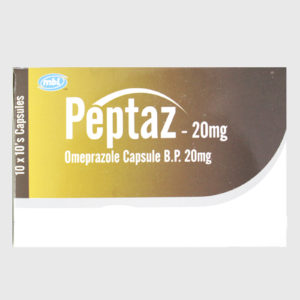
Each capsule contains:
Omeprazole 20mg (Enteric Coated Pellets)
Duodenal Ulcer (adults)
PEPTAZ (omeprazole) is indicated for short-term treatment of active duodenal ulcer in adults. Most patients heal within four weeks. Some patients may require an additional four weeks of therapy.PEPTAZ (omeprazole) in combination with clarithromycin and amoxicillin, is indicated for treatment of patients with H. pylori infection and duodenal ulcer disease (active or up to 1-year history) to eradicate H. pylori in adults.
PEPTAZ (omeprazole) in combination with clarithromycin is indicated for treatment of patients with H. pylori infection and duodenal ulcer disease to eradicate H. pylori in adults.
Eradication of H. pylori has been shown to reduce the risk of duodenal ulcer recurrence.
Among patients who fail therapy, PEPTAZ (omeprazole) with clarithromycin is more likely to be associated with the development of clarithromycin resistance as compared with triple therapy. In patients who fail therapy, susceptibility testing should be done. If resistance to clarithromycin is demonstrated or susceptibility testing is not possible, alternative antimicrobial therapy should be instituted.
PEPTAZ (omeprazole) is indicated for short-term treatment (4-8 weeks) of active benign gastric ulcer in adults.
Treatment of Gastroesophageal Reflux Disease (GERD) (adults and pediatric patients)
Symptomatic GERD
PEPTAZ (omeprazole) is indicated for the treatment of heartburn and other symptoms associated with GERD in pediatric patients and adults.
Erosive Esophagitis
PEPTAZ (omeprazole) is indicated for the short-term treatment (4-8 weeks) of erosive esophagitis that has been diagnosed by endoscopy in pediatric patients and adults.
The efficacy of PEPTAZ (omeprazole) used for longer than 8 weeks in these patients has not been established. If a patient does not respond to 8 weeks of treatment, an additional 4 weeks of treatment may be given. If there is recurrence of erosive esophagitis or GERD symptoms (eg, heartburn), additional 4-8 week courses of omeprazole may be considered.
PEPTAZ (omeprazole) Capsules should be taken before eating.
Short-Term Treatment of Active Duodenal Ulcer
The recommended adult oral dose of PEPTAZ (omeprazole) is 20 mg once daily. Most patients heal within four weeks. Some patients may require an additional four weeks of therapy.
H. pylori Eradication for the Reduction of the Risk of Duodenal Ulcer Recurrence
Triple Therapy (PEPTAZ (omeprazole) /clarithromycin/amoxicillin)
The recommended adult oral regimen is PEPTAZ (omeprazole) 20 mg plus clarithromycin 500 mg plus amoxicillin 1000 mg each given twice daily for 10 days. In patients with an ulcer present at the time of initiation of therapy, an additional 18 days of PEPTAZ (omeprazole) 20 mg once daily is recommended for ulcer healing and symptom relief.
Dual Therapy (PEPTAZ (omeprazole) /clarithromycin)
The recommended adult oral regimen is PEPTAZ (omeprazole) 40 mg once daily plus clarithromycin 500 mg three times daily for 14 days. In patients with an ulcer present at the time of initiation of therapy, an additional 14 days of PEPTAZ (omeprazole) 20 mg once daily is recommended for ulcer healing and symptom relief.
The recommended adult oral dose is 40 mg once daily for 4-8 weeks.
The recommended adult oral dose for the treatment of patients with symptomatic GERD and no esophageal lesions is 20 mg daily for up to 4 weeks. The recommended adult oral dose for the treatment of patients with erosive esophagitis and accompanying symptoms due to GERD is 20 mg daily for 4 to 8 weeks.
Maintenance of Healing of Erosive Esophagitis
The recommended adult oral dose is 20 mg daily.

Methyl Salicylate BP 15%
Menthol BP 10%
Arthritis,Cervical Spondylitis, Backache, Knee pain
Lumbago,Sprain of muscles and joints,Muscular spasm Frozen Shoulder.
Killpen Cream specially formulated to provide quick relief from pain and inflammation. Killpen Cream is used to treat aches and pains of the muscles/joints (e.g., arthritis, backache, sprains). Menthol and methyl salicylate are known as counterirritants. They work by causing the skin to feel cool and then warm. These feelings on the skin distract you from feeling the aches/pains deeper in your muscles, joints, and tendons.
Apply a little quantity of Cream at the affected area and gently massage until absorbed.
For better result apply 3 – 4 times daily to get relief from pain for hours.

Framycetin Sulphate B.P. 1.0% w/w
Traumatic: Lacerations, abrasions, grazes (gravel rash), bites (animal and insect), cuts, puncture wounds, crush injuries, surgical wounds and incisions, traumatic ulcers.
Ulcerative: Varicose ulcers, diabetic ulcers, bed-sores, tropical ulcers.
Thermal: Burns, scalds.
Elective: Skin grafts (donor and recipient sites), avulsion of finger or toe nails, circumcision.
Miscellaneous: Secondary infected skin conditions, e.g. eczema, dermatitis, herpes zoster, colostomy, acute paronychia, incised abscesses (packing), in growing toe-nails.
A single layer to be applied directly to the wound and covered with an appropriate dressing. If exudative, dressings should be changed at least daily. In case of leg ulcers cut dressing accurately to size of ulcer to decrease the risk of sensitization and to avoid contact with surrounding healthy skin.
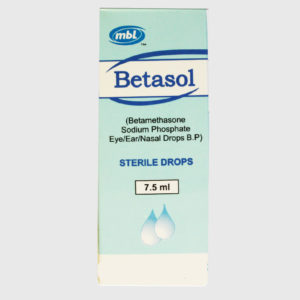
“Composition: Betamethasone Sodium Phosphate B.P….0.1% w/v. INDICATIONS: Betamethasone has topical corticosteroid activity and is indicated in non-infected inflammatory conditions of the eye, ear & nose. Eye: Non-infected inflammatory conditions (e.g. Uveitis, marginal keratitis, allergic conjunctivitis, blepharitis and episcleritis).
Ear: Otitis Externa and other Inflammatory conditions. Nose: Allergic rhinitis and other inflammatory conditions. DOSAGE AND ADMINISTRATION:
Eye:
1or 2 drops instilled into the eye every one or two hours until control is achieved, then the frequency may be reduced.
Ear:
2 or 3 drops instilled into the ear every two or three hours until control is achieved, then the frequency may be reduced.
Nose: 2 or 3 drops instilled into each nostril two or three times daily.”
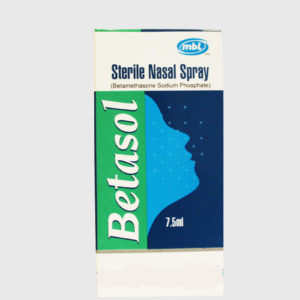
Betamethasone Sodium Phosphate B.P …0.1% w / v
Betasol Nasal Spray is recommended for use in the treatment of allergic, rhinitis, inflammatory, and congestive conditions of the nose. Allergic rhinitis is inflammation of the inside of the nose caused by an allergen, such as pollen, dust, mould or flakes of skin from certain animals
2 to 3 times spray and to each nostril daily. Or as directed by the physician
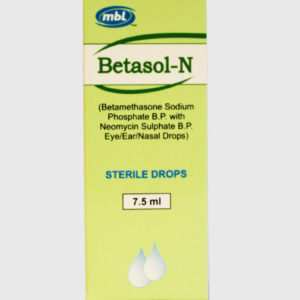
Betamethasone Sodium Phosphate B.P….0.1% w/v
Neomycin Sulphate B.P… 0.5% w/v
Eye: Non-Infected steroid responsive Inflammatory Conditions e.g. Uveitis, Marginal keratitis, Allergic conjunctivitis, Blepharitis, Episcleritis. Where prophylaxis against secondary bacterial infection is desired.
Otitis externa and other steroid responsive inflammatory conditions where bacterial infection is present or suspected.
Otitis externa is an inflammation of the ear canal. The inflammation may be caused by infection, allergy or other causes. Treatment with ear drops is usually effective. Nose: Allergic rhinitis and other inflammatory conditions.
Eye: 1 or 2 drops instilled into the eye every one or two hours until signs of improvement are apparent, then the frequency may be reduced.
Ear: 2 or 3 drops instilled into the ear every two or three hours until signs of improvement are apparent, then the frequency can be reduced. Nose: 2 or 3 drops instilled into each nostril two or three times daily.
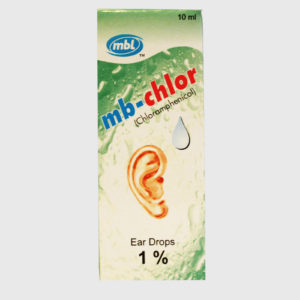
Each ml contains: Chloramphenicol BP……..10mg
Bacterial infection of the outer ear canal (Bacterial Otitis externa) Caused by organisms susceptible to chloramphenicol.Acute Otitis Media
• Common in children
• Unwell/pyrexia, otalgia/discharge
• there may be tenderness over the mastoid
• discharge in meatus
• loss of outline of drum and landmarks
• TM: red, bulging, oedematous or perforation.
• Mostly viral but can be Streptococcus/Haemophilus
1 to 3 drops every 4 hourly or as directed by the physician.
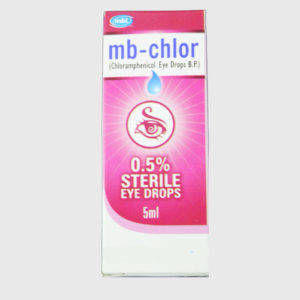
Each ml contains:
Chloramphenicol BP……..5mg
Acute Microbial Bacterial Conjunctivitis.
Ulcerous Keratitis
Microbial Infections of Lacrimal dust
Microbial Blepharitis
Infection of enucleation socket
The recommended dosage is for adults, and children aged 2 years and over.
One drop to be applied to the infected eye every 2 hours for the first 48 hours and then every 4 hours thereafter. Treatment should be continued for 5 days.
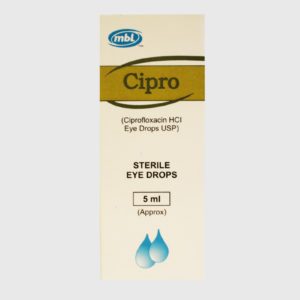
Each ml contains:
Ciprofloxacin USP 3mg Action: Ciprofloxacin is a fluoroquinolone antibacterial active against a broad spectrum of gram-positive and gram-negative ocular pathogens.
CIPRO is indicated for the treatment if infections caused by the susceptible strains of micro-organisms in the conditions listed below:
Corneal Ulcer: Pseudomonas aeruginosa, Serratia marcescens, Staphylococcus aureus, Staphylococcus epidermidis, Staphylococcus pneumoniae, Streptococcus (Viridans Group.)
Conjunctivitis: Staphylococcus aureus, Staphylococcus epidermidis, Streptococcus pneumoniae (Efficacy for this organism was studied in fewer than 10 infections.)
Corneal Ulcers: Two drops into the affected eye every 15 minutes for the first six hours, then two drops every 30 minutes for the rest of first day. On the second day, two drops every hour. On the third through 14th day, two drops every four hours, Treatment may be continued after 14 days in corneal re-epithielialization has not occurred.
One or two drops into conjunctival sac(s) every two hours while awake for two day and every four hours for the next five days during waking hours.
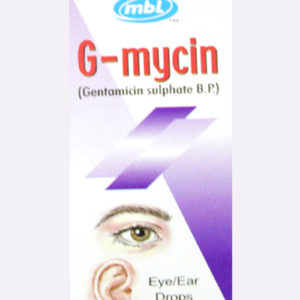
Each ml Contains:
Gentamicin BP… 3mg (as Gentamicin Sulphate)
As a broad spectrum antibiotic for the topical treatment of eye and ear infections in corneal ulcers, bacterial conjunctivitis, trachoma and other ocular infection may be used post-operatively. Indicated in the topical treatment of eye infections caused by susceptible bacteria and also used in bacterial ear infections. . G-mycin eye/ear drops is also indicated for treatment of bacterial infection of otitis externa. It can also be used prophylactically removal of foreign bodies.
Eye: 1-2 drops to be instilled 3-6 times a day.
Ear: 2-3 drops to be instilled 3-4 times a day in each ear.
In severe cases dosage may be increased.
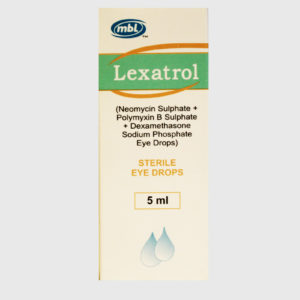
Each ml contain: Neomycin sulphate 3.5mg + Polymyxin B sulphate 6,000 units + Dexamethasone sodium phosphate 1.0mg.
For steroid-responsive inflammatory ocular conditions for which a corticosteroid is indicated and where bacterial infection or a risk of bacterial ocular infection exists. Ocular steroids are indicated in inflammatory conditions of the palpebral and bulbar conjunctiva, cornea, and anterior segment of the globe where the inherent risk of steroid use in certain infective conjunctivitis is accepted to obtain a diminution in edema and inflammation. They are also indicated in chronic anterior uveitis and corneal injury from chemical, radiation or thermal burns, or penetration of foreign bodies.The use of a combination drug with an anti-infective component is indicated where the risk of infection is high or where there is an expectation that potentially dangerous numbers of bacteria will be present in the eye.
The particular anti-infective drug in this product is active against the following common bacterial eye pathogens: Staphylococcus aureus, Escherichia coli, Haemophilus influenzae, Klebsiella/Enterobacter species, Neisseria species, Pseudomonas aeruginosa.This product does not provide adequate coverage against Serratia marcescens, and Streptococci, including Streptococcus pneumoniae.
One or two drops topically in the conjunctival sac(s). In severe disease, drops may be used hourly, being tapered to discontinuation as the inflammation subsides. In mild disease, drops may be used up to four to six times daily.
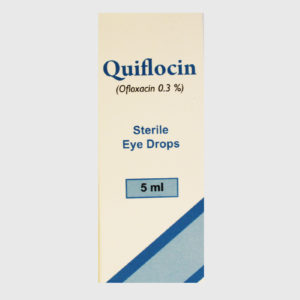
Each ml contains:
Ofloxacin B.P. 3mg
Ofloxacin Ophthalmic Solution is indicated for the treatment of infections caused by susceptible strains of the following bacteria in the conditions listed below:
Gram-positive bacteria: Gram-negative bacteria:
Staphylococcus aureus Enterobacter cloacae
Staphylococcus epidermidis Haemophilus influenzae
Streptococcus pneumoniae Proteus mirabilis
Pseudomonas aeruginosa
Gram-positive bacteria: Gram-negative bacteria:
Staphylococcus aureus Pseudomonas aeruginosa
Staphylococcus epidermidis Serratia marcescens*
Streptococcus pneumoniae Anaerobic species:
Propionibacterium acnes
*Efficacy for this organism was studied in fewer than 10 infections
The recommended dosage regimen for the treatment of bacterial conjunctivitis is:
Days 1 and 2 Instill one to two drops every two to four hours in the affected eye(s).
Days 3 through 7 Instill one to two drops four times daily.
The recommended dosage regimen for the treatment of bacterial corneal ulcer is:
Days 1 and 2 Instill one to two drops into the affected eye every 30 minutes, while awake. Awaken at approximately four and six hours after retiring and instill one to two drops.
Days 3 through 7 to 9
treatment completion Instill one to two drops hourly, while awake.
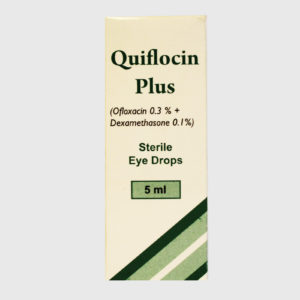
Each ml contains:
Ofloxacin B.P. 3mg
Dexamethasone as Sodium Phosphate B.P. 1mg
Quiflocin Plus Ophthalmic Solution is indicated for the treatment of infections caused by susceptible strains of the following bacteria where every inflammation and infection co-exists to decrease in edema and inflammation is needed mainly for post cataract inflammation control. Also for steroid responsive inflammation of the palpebral conjunctiva and anterior segment of the globe. Listed of the bacteria conditions as below:
Gram-positive bacteria: Gram-negative bacteria:
Staphylococcus aureus Enterobacter cloacae
Staphylococcus epidermidis Haemophilus influenzae
Streptococcus pneumoniae Proteus mirabilis
Pseudomonas aeruginosa
Gram-positive bacteria: Gram-negative bacteria:
Staphylococcus aureus Pseudomonas aeruginosa
Staphylococcus epidermidis Serratia marcescens*
Streptococcus pneumoniae Anaerobic species:
Propionibacterium acnes
*Efficacy for this organism was studied in fewer than 10 infections
The recommended dosage regimen for the treatment of bacterial conjunctivitis is:
Days 1 and 2 Instill one to two drops every two to four hours in the affected eye(s).
Days 3 through 7 Instill one to two drops four times daily.
The recommended dosage regimen for the treatment of bacterial corneal ulcer is:
Days 1 and 2 Instill one to two drops into the affected eye every 30 minutes, while awake. Awaken at approximately four and six hours after retiring and instill one to two drops.
Days 3 through 7 to 9 treatment completion Instill one to two drops hourly, while awake.
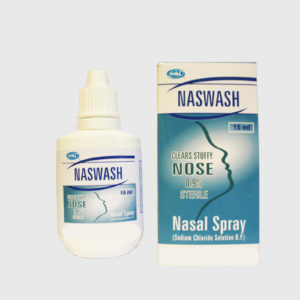
Each ml contains: Sodium Chloride 9mg
1. Nasal dryness
2. Post operative nasal dryness(after operations on the nasal sinuses)
3. Allergic rhinitis & Congestion due to cold of flu
4. Thick or crusty nasal mucus
5. “Aging Nose” happens when the nose increases its secretions, usually due to hormone changes, particularly in women. Nasal irrigation is a great way to consistently clean out those nasal passages of the excess mucus.
6. Cystic Fibrosis (CF) patients can also find relief by using nasal irrigation to clean the thick nasal secretions so often associated with the disease.
Bend forward and tilt your head down. Place the tip of Nozzles in the nostril and squeeze the bottle with pressure and spray the solution into the nostril. Repeat the process in both nostrils 2 -3 times a day or as directed by the physician.
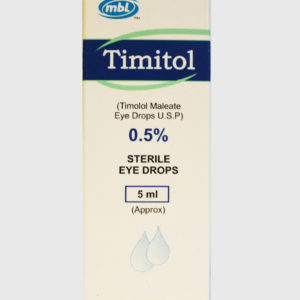
Each ml contains:
Timolol BP 5mg
Timitol Ophthalmic Solution is indicated in the treatment of elevated intraocular
pressure in patients with ocular hypertension or open-angle glaucoma.
TIMITOL Ophthalmic Solution is available in concentrations of 0.25% and 0.5%. The usual starting dose is one drop of 0.5% TIMITOL in the affected eye(s) twice a day. If the clinical response is not adequate, the dosage may be changed to one drop of 0.5% solution in the affected eye(s) twice a day. Since in some patients the pressure-lowering response to TIMITOL may require a few weeks to stabilize, evaluation should include a determination of intraocular pressure after approximately 4 weeks of treatment with TIMITOL.
If the intraocular pressure is maintained at satisfactory levels, the dosage schedule may be changed to one drop once a day in the affected eye(s). Because of diurnal variations in intraocular pressure, satisfactory response to the once-a-day dose is best determined by measuring the intraocular pressure at different times during the day.
Dosages above one drop of 0.5% TIMITOL twice a day generally have not been shown to produce further reduction in intraocular pressure. If the patient's intraocular pressure is still not at a satisfactory level on this regimen, concomitant therapy with other agent(s) for lowering intraocular pressure can be instituted. The concomitant use of two topical beta-adrenergic blocking agents is not recommended.
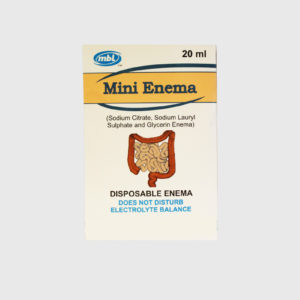
“COMPOSITION:
Each 10 ml contains:
Sodium citrate B.P ……………………450 mg
Sodium Lauryl Sulphate B.P ………78.75 mg
Glycerin B.P …………………………….90 % v/v
INDICATIONS:
Laxative: Relief of constipation without any discomfort.
Pregnancy: Empty intestines of faecal matter to facilitate labour.
Relief of constipation after child birth.
Removal of Impaction: Faecal, Barium.
Routine Enema: Evacuation of intestines for x-rays, proctoscopy & sigmoidoscopy. Preoperative cleansing of intestines in operations of the abdominal cavity. Postoperative period to help ease passage of stools.
Laboratory: Collection of stool specimens.
Dyschezia: Easy Evacuation of intestines.
DOSAGE & ADMINISTRATION:
Adults: 20 ml. Children 5 to 10 ml or as directed by the physician. Mini Enema should be used 10-15 minutes before the chosen time.
”

“COMPOSITION:
Each 10 ml contains:
Sodium citrate B.P ……………………450 mg
Sodium Lauryl Sulphate B.P ………78.75 mg
Glycerin B.P …………………………….90 % v/v
INDICATIONS:
Laxative: Relief of constipation without any discomfort.
Pregnancy: Empty intestines of faecal matter to facilitate labour.
Relief of constipation after child birth.
Removal of Impaction: Faecal, Barium.
Routine Enema: Evacuation of intestines for x-rays, proctoscopy & sigmoidoscopy. Preoperative cleansing of intestines in operations of the abdominal cavity. Postoperative period to help ease passage of stools.
Laboratory: Collection of stool specimens.
Dyschezia: Easy Evacuation of intestines.
DOSAGE & ADMINISTRATION:
Adults: 20 ml. Children 5 to 10 ml or as directed by the physician. Mini Enema should be used 10-15 minutes before the chosen time.
”
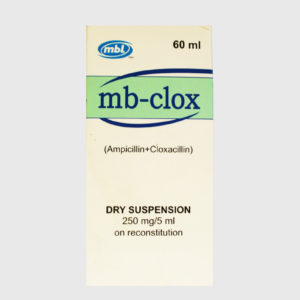
Each 5ml after reconstitution:
Ampicillin as Trihydrate BP125mg + Cloxacillin as Sodium BP 125mg
Mb-Clox Dry Suspension is effective in the treatment of respiratory tract infections, Ear, Nose and throat infections. Urinary tract infections, Gastro- intestinal infections, skin and soft tissue infections. Pelvic infections, Septicaemia, Endocarditis, Orthopaedic infections.
The use of this antibiotic may lead to the appearance of resistant strains of organisms and sensitivity resting should, therefore, be carried out wherever possible, to ensure the appropriateness of the therapy. Infections caused by susceptible organisms where a mixed infection is present and includes penicillin-resistant staphylococci.
500 mg –1 g (1 –2 x 500 mg capsules) every 6 hours.
Children 2 –10 years : 250 –500 mg (5 –10 mL of 250 mg/5 mL syrup) every 6 hours.
Children up to 2 years : 250 mg (5 mL of 250 mg/5 mL syrup) every 6 hours.
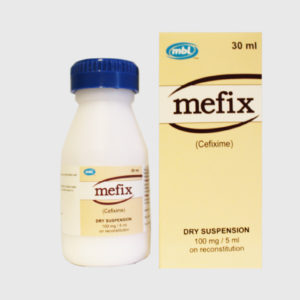
Each 5ml Contains after reconstitution:
Cefixime as Trihydrate U.S.P…………… 100 mg
Cefixime is an orally active Cephalosporin antibiotic, which has marked in vitro bactericidal activity against wide range of Gram positive and Gram negative organisms. It is indicated for the treatment of the acute infection caused by susceptible micro organisms. Upper respiratory tract infection (URTI), Otitis media, Sinusitis, Pharyngitis, Tonsillitis, Lower Respiratory tract infection (LRTI) Bronchitis, Urinary tract infection (UTI), Cystitis, Cystourethritis, Uncomplicated pyelonephritis and uncomplicated gonorrhea (Cervical/Urethral, rectal and pharyngeal).
Once Cefixime is reconstituted, the recommended dose of the suspension is 400 mg daily. For the treatment of uncomplicated cervical/urethral gonococcal infections, a single oral dose of 400 mg is recommended.
The recommended dose is 8 mg/kg/day of the suspension. This may be administered as a single daily dose or may be given in two divided doses, as 4 mg/kg every 12 hours.
PEDIATRIC DOSAGE CHART
Patient Weight (Kg) Dose/Day (mg) Dose/Day (ml) Dose/Day tsp of suspension
6.25 50 2.5 ½
12.5 100 5 1
18.75 150 7.5 1 ½
25 200 10 2
31.25 250 12.5 2 ½
37.5 300 15 3
Children weighing more than 50 kg or older than 12 years should be treated with the recommended adult dose.
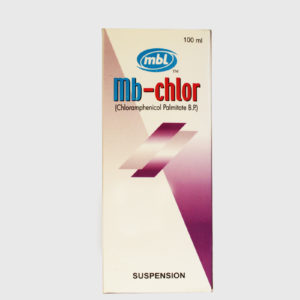
Each 5ml contains:
ChloramphenicolPalmitate
Eq. to Chloramphenicol BP 125mg
It is effective against typhoid and broad –spectrum bacterial (Gram-positive and Gram-negative) diseases. Chloramphenicol Palmitate is a dichloroacetic acid derivative. Chloramphenicol is a broad-spectrum antibiotic and is bacteriostatic. Chloramphenicol is hydrolysed in the upper intestinal tract into the parent drug. It is lipid soluble, diffuses through the bacterial cell membrane and reversibly binds to the 50 S subunit of bacterial ribosomes where transfer of amino acids to growing peptide chains is prevented, thus inhibiting peptide bond formation and subsequent protein synthesis.
• For oral dosage forms (capsules and suspension):
o Adults and teenagers—Dose is based on body weight. The usual dose is 12.5 milligrams (mg) per kilogram (kg) (5.7 mg per pound) of body weight every six hours.
o Children— Infants up to 2 weeks of age: Dose is based on body weight. The usual dose is 6.25 mg per kg (2.8 mg per pound) of body weight every six hours. Infants 2 weeks of age and older: Dose is based on body weight. The usual dose is 12.5 mg per kg (5.7 mg per pound) of body weight every six hours; or 25 mg per kg (11.4 mg per pound) of body weight every twelve hours.
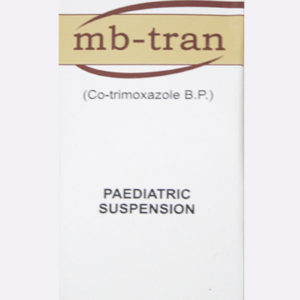
Trimethoprim BP 40mg + Sulphamethoxazole BP 200mg
Co-Trimoxazole Suspension is indicated for the treatment of the following infections when owing to sensitive organisms. Treatment and prevention of Pneumocystis jiroveci (P. carinii) pneumonitis
Treatment and prophylaxis of toxoplasmosis.Treatment of nocardiosis
The following infections may be treated with Co-Trimoxazole Suspension where there is bacterial evidence of sensitivity to Co-Trimoxazole Suspension and good reason to prefer the combination of antibiotics in Co-Trimoxazole Suspension to a single antibiotic: Acute uncomplicated urinary tract infection.Acute otitis media. Acute exacerbation of chronic bronchitis.Consideration should be given to official guidance on the appropriate use of antibacterial agents.
Method of administration: oral.
It may be preferable to take Co-Trimoxazole Suspension with some food or drink
to minimize the possibility of gastrointestinal disturbances.
Standard dosage recommendations for acute infections
STANDARD DOSAGE
Age Paediatric Suspension
6 to 12 years 10 ml every 12 hours
6 months to 5 years 5 ml every 12 hours
6 weeks to 5 months 2.5 ml every 12 hours
Or as directed by the physician.

Trimethoprim BP 40mg + Sulphamethoxazole BP 200mg
Co-Trimoxazole Suspension is indicated for the treatment of the following infections when owing to sensitive organisms. Treatment and prevention of Pneumocystis jiroveci (P. carinii) pneumonitis
Treatment and prophylaxis of toxoplasmosis.Treatment of nocardiosis
The following infections may be treated with Co-Trimoxazole Suspension where there is bacterial evidence of sensitivity to Co-Trimoxazole Suspension and good reason to prefer the combination of antibiotics in Co-Trimoxazole Suspension to a single antibiotic: Acute uncomplicated urinary tract infection.Acute otitis media. Acute exacerbation of chronic bronchitis.Consideration should be given to official guidance on the appropriate use of antibacterial agents.
Method of administration: oral.
It may be preferable to take Co-Trimoxazole Suspension with some food or drink
to minimize the possibility of gastrointestinal disturbances.
Standard dosage recommendations for acute infections
Children aged 12 years and under:
STANDARD DOSAGE
Age Paediatric Suspension
6 to 12 years 10 ml every 12 hours
6 months to 5 years 5 ml every 12 hours
6 weeks to 5 months 2.5 ml every 12 hours
Or as directed by the physician.
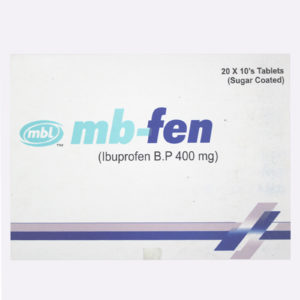
Each 5ml
Contains:
Ibuprofen Suspension B.P.100mg
Rheumatic Diseases such as:
Rheumatoid arthritis, Osteoarthritis, Ankylosing Spondylitis, Juvenile rheumatoid arthritis. Pain and inflammation following dental or obstetric surgery, acute gouty arthritis, Painful non-rheumatic inflammatory conditions such as athletic injuries strains or sprains), Bursitis, capsulitis, synovitis, Tendinitis or tenosynovitis. For reduction of fever. For the relief of pain associated with the primary dysmenorrheoa.
PEDIATRIC PATIENTS
Fever Reduction:
For reduction of fever in children, 6 months up to 2 years of age, the dosage should be adjusted on the basis of the initial temperature level. The recommended dose is 5 mg/kg if the baseline temperature is less than 102.5°F, or 10 mg/kg if the baseline temperature is 102.5°F or greater. The duration of fever reduction is generally 6 to 8 hours. The recommended maximum daily dose is 40 mg/kg.Analgesia:
For relief of mild to moderate pain in children 6 months up to 2 years of age, the recommended dosage is 10 mg/kg, every 6 to 8 hours. The recommended maximum daily dose is 40 mg/kg. Doses should be given so as not to disturb the child's sleep pattern.Juvenile Arthritis:
The recommended dose is 30 to 40 mg/kg/day divided into three to four doses (see INDIVIDUALIZATION OF DOSAGE ). Patients with milder disease may be adequately treated with 20 mg/kg/day.
In patients with juvenile arthritis, doses above 50 mg/kg/day are not recommended because they have not been studied and doses exceeding the upper recommended dose of 40 mg/kg/day may increase the risk of causing serious adverse events. The therapeutic response may require from a few days to several weeks to be achieved. Once a clinical effect is obtained, the dosage should be lowered to the smallest dose of ibuprofen needed to maintain adequate control of symptoms. Pediatric patients receiving doses above 30 mg/kg/day or if abnormal liver function tests have occurred with previous NSAID treatments should be carefully followed for signs and symptoms of early liver dysfunction.
Primary Dysmenorrhea:
For the treatment of primary dysmenorrhea, beginning with the earliest onset of such pain, Ibuprofen Oral Suspension should be given in a dose of 400 mg every 4 hours, as necessary, for the relief of pain.
Rheumatoid Arthritis and Osteoarthritis:
Suggested dosage: 1200-3200 mg daily (300 mg q.i.d. or 400 mg, 600 mg or 800 mg t.i.d. or q.i.d.). Individual patients may show a better response to 3200 mg daily, as compared with 2400 mg, although in well-controlled clinical trials patients on 3200 mg did not show a better mean response in terms of efficacy. Therefore, when treating patients with 3200 mg/day, the physician should observe sufficient increased clinical benefits to offset potential increased risk.
The dose of Ibuprofen Oral Suspension should be tailored to each patient, and may be lowered or raised from the suggested doses depending on the severity of symptoms either at time of initiating drug therapy or as the patient responds or fails to respond. One fever study showed that, after the initial dose of ibuprofen oral suspension, subsequent doses may be lowered and still provide adequate fever control. In a situation when low fever would require the ibuprofen oral suspension 5 mg/kg dose in a child with pain, the dose that will effectively treat the predominant symptom should be chosen. In chronic conditions, a therapeutic response to ibuprofen oral suspension therapy is sometimes seen in a few days to a week, but most often is observed by two weeks. After a satisfactory response has been achieved, the patient's dose should be reviewed and adjusted as required.
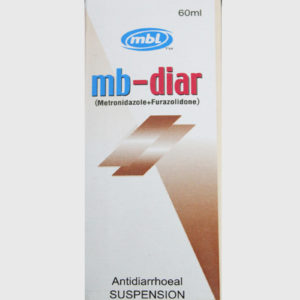
Each 5ml contains:
Metronidazale Benzoate
e.q. to Metronidazole B.P…100mg
Futrazolidone B.P ….50mg
It is recommended for the treatment of dysentery of protozoal, bacterial or mixed origin; amoebiasis (intestinal and extra intestinal disease, and that of symptomless cystpassers): bacillary dysentery, giardiasis and food poisoning caused by the many susceptible strains and species of gram species of gram-positive and gram-negative bacteria.
4 x5 ml 3 times daily
(1-5Years) 1x5ml 3 times daily
(Over 5 Years) 2x5ml 3 times daily
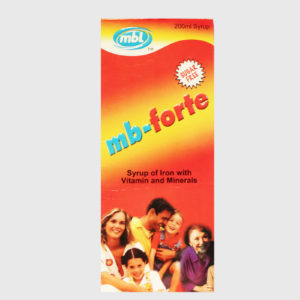
“Composition:
Each 100 ml contains:
Iron (Ferric Choline Citrate) …700 mg
Cobalt Chloride….. 2 mg
Calcium Glycerophosphate… 500 mg
Sodium Glycerophosphate… 300 mg
Potassium Glycerophosphate… 400 mg
Vitamin B12….. 120 mcg
Sorbirol Solution 70% ….. 40mg
Indications:
Physical and nervous debility, exhaustion from over
work, fatigue, mental stress andstrains, anorexia,
convalescence, general weakness, post natal
exhaustion and anaemia, particularly in pregnancy and
lactation. It is a nutrient as well as blood forming tonic.
It improves appetite as well as digestion to maintain the
nutritional status of the body.
A well balanced formulation with Glycerophosphates.
in minerals form, indicated in anaemia, malnutrition and
pregnancy. Convalescence after surgery and illness.
Appetite stimulant, loss of weight and general stimulant
tonic to overcome fatigue and exhaustions.
Safely recommended in Diabetes.
Dosage and Administration:
Children: 2-6 Years: ½ to 1 teaspoonful twice daily with meals
(2.5 to 5 ml)
6-12 Years: 1 to 2 teaspoonful twice daily with meals
(5 to 10 ml)
Adult: 2 tablespoonful thrice daily with meals or as prescribed
by the physician.
”
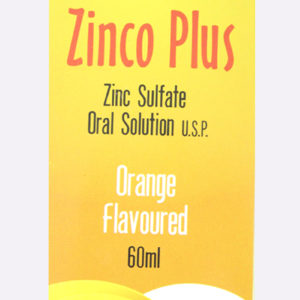
Each 5ml Contains:
Zinc Sulfate Monohydrate USP Equivalent to 20mg Elemental Zinc.
Zinco Plus is indicated for Malnutrition and all kinds of diarrhea e.g.
• Acute Diarrhoea
• Persistent Diarrhoea
• Chronic Diarrhoea
• Recurrent Diarrhoea
Children: One teaspoon (5ml) once daily for 10 – 14 days. Infants: Half teaspoon (2.5ml) once daily.

Each 5 ml contains:
Pizotifen (as malate) B.P 0.25mg
Thiamine HCL B.P 0.875mg
Riboflavin 5 Phosphate sodium B.P 1.31mg
Pyridoxine HCL B.P 0.77mg
Nicotinamide B.P 5.25mg
Anorexia in underweight patients, mood elevation in the elderly,prophylactic treatment of migraine, cluster headache etc. Pizotifen is a competitive serotonin antagonist. Possess appetite stimulating and antidepressant properties.
2-6 years: ½ to 1 teaspoonful twice daily (2.5 to 5 ml). 6-12 years: 1 to 2 teaspoonful (5 to 10 ml).
2 teaspoonful thrice daily (10 ml) or as prescribed by the physician.
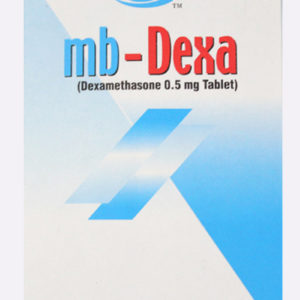
Each tablet contains:
Dexamethasone Sodium 0.5mg
Indicated in a wide variety of disorders amenable to glucocorticoid therapy, as well
as an adjunct in the control of cerebral edema.
Dexamethasone is used to treat conditions such as arthritis, blood/hormone/immune system disorders, allergic reactions, certain skin and eye conditions, breathing problems, certain bowel disorders, and certain cancers. It is also used as a test for an adrenal gland disorder (Cushing's syndrome). This medication is a corticosteroid hormone (glucocorticoid). It decreases your body's natural defensive response and reduces symptoms such as swelling and allergic-type reactions.
In general, glucocorticoid dosage depends on the severity of the condition and response of the patient. Under certain circumstances, for instance in stress and changed clinical picture, extra dosage adjustments may be necessary. If no favourable response is noted within a couple of days, glucocorticoid therapy should be discontinued.
Usually, daily oral dosages of 0.5 – 10 mg are sufficient. In some patients higher dosages may be temporarily required to control the disease. Once the disease is under control, the dosage should be reduced or tapered off to the lowest suitable level under continuous monitoring and observation of the patient.
For a short dexamethasone suppression test, 1 mg dexamethasone is given at 11 pm and plasma cortisol measured the next morning. Patients who do not show a decrease in cortisol can be exposed to a longer test: 500 micrograms dexamethasone is given at 6 hourly intervals for 48 hours followed by 2 mg every 6 hours for a further 48 hours. Twenty-four hour urine collections are made before, during and at the end of the test for determination of 17-hydroxycorticosteroids.
0.01-0.1 mg/kg of body weight daily.
Dosage of glucocorticoids should be adjusted on the basis of the individual patient's response.
Or as directed by the physicianComposition: Each tablet contains:
Dexamethasone Sodium 0.5mg
Indicated in a wide variety of disorders amenable to glucocorticoid therapy, as well
as an adjunct in the control of cerebral edema.
Dexamethasone is used to treat conditions such as arthritis, blood/hormone/immune system disorders, allergic reactions, certain skin and eye conditions, breathing problems, certain bowel disorders, and certain cancers. It is also used as a test for an adrenal gland disorder (Cushing's syndrome). This medication is a corticosteroid hormone (glucocorticoid). It decreases your body's natural defensive response and reduces symptoms such as swelling and allergic-type reactions.
In general, glucocorticoid dosage depends on the severity of the condition and response of the patient. Under certain circumstances, for instance in stress and changed clinical picture, extra dosage adjustments may be necessary. If no favourable response is noted within a couple of days, glucocorticoid therapy should be discontinued.
Usually, daily oral dosages of 0.5 – 10 mg are sufficient. In some patients higher dosages may be temporarily required to control the disease. Once the disease is under control, the dosage should be reduced or tapered off to the lowest suitable level under continuous monitoring and observation of the patient (See Section 4.4).
For a short dexamethasone suppression test, 1 mg dexamethasone is given at 11 pm and plasma cortisol measured the next morning. Patients who do not show a decrease in cortisol can be exposed to a longer test: 500 micrograms dexamethasone is given at 6 hourly intervals for 48 hours followed by 2 mg every 6 hours for a further 48 hours. Twenty-four hour urine collections are made before, during and at the end of the test for determination of 17-hydroxycorticosteroids.
0.01-0.1 mg/kg of body weight daily.
Dosage of glucocorticoids should be adjusted on the basis of the individual patient's response.
Or as directed by the physician
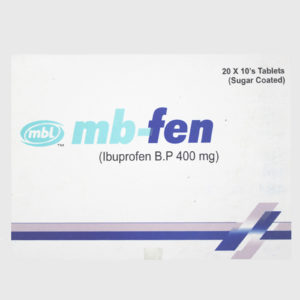
Ibuprofen B.P 400mg
Mb-fen is indicated for its analgesic and anti-inflammatory effects in the treatment of rheumatoid arthritis (including juvenile rheumatoid arthritis or Still's disease), ankylosing spondylitis, osteoarthritis and other non-rheumatoid (seronegative) arthropathies. In the treatment of non-articular rheumatic conditions, Mb-fen is indicated in periarticular conditions such as frozen shoulder (capsulitis), bursitis, tendonitis, tenosynovitis and low back pain; Mb-fen can also be used in soft tissue injuries such as sprains and strains. Mb-fen is also indicated for its analgesic effect in the relief of mild to moderate pain such as dysmenorrhoea, dental and post-operative pain and for symptomatic relief of headache, including migraine headache.
Adults and children over 12 years of age: The recommended dosage of Mb-fen is 1200-1800 mg daily in divided doses. Some patients can be maintained on 600-1200 mg daily. In severe or acute conditions, it can be advantageous to increase the dosage until the acute phase is brought under control, provided that the total daily dose does not exceed 2400 mg in divided doses.
The daily dosage of Mb-fen is 20 mg/kg of body weight in divided doses.
In Juvenile Rheumatoid Arthritis, up to 40 mg/kg of body weight daily in divided doses may be taken.
Elderly: The elderly are at increased risk of serious consequences of adverse reactions. If an NSAID is considered necessary, the lowest effective dose should be used and for the shortest possible duration. The patient should be monitored regularly for GI bleeding during NSAID therapy. If renal or hepatic function is impaired, dosage should be assessed individually.
For oral administration. It is recommended that patients with sensitive stomachs take Mb-fen with food. If taken shortly after eating, the onset of action of Mb-fen may be delayed. To be taken preferably with or after food, with plenty of fluid. Mb-fen tablets should be swallowed whole and not chewed, broken, crushed or sucked on to avoid oral discomfort and throat irritation.
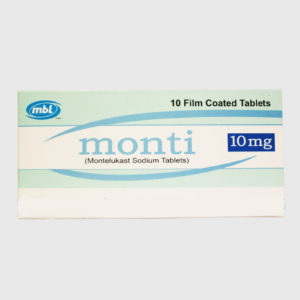
Each film coated tablet contains:
Montelukast sodium equivalent to Montelukast …10 mg
Montelukast Sodium is indicated for the prophylaxis and chronic treatment of asthma in adults and pediatric patients 12 months of age and older. Montelukast Sodium is indicated for the relief of symptoms of allergic rhinitis (seasonal allergic rhinitis in adults and pediatric patients 2 years of age and older, and perennial allergic rhinitis in adults and pediatric patients 6 months of age and older.
Monti should be taken once daily. For asthma, the dose should be taken in the evening. For allergic rhinitis, the time of administration may be individualized to suit patient needs. Patients with both asthma and allergic rhinitis should take only one tablet daily in the evening.Adults and Adolescents 15 Years of Age and Older with Asthma or Allergic Rhinitis: The dosage for adults and adolescents 15 years of age and older is one 10-mg tablet daily.Pediatric Patients 6 to 14 Years of Age with Asthma or Allergic Rhinitis:
The dosage for pediatric patients 6 to 14 years of age is one 5-mg chewable tablet daily.
No dosage adjustment within this age group is necessary.
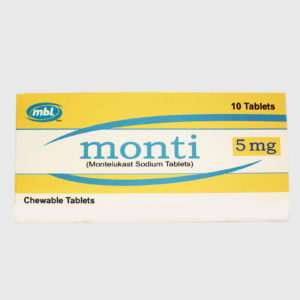
Each chewable tablet contains:
Montelukast sodium equivalent to Montelukast …5 mg
Montelukast Sodium is indicated for the prophylaxis and chronic treatment of asthma in adults and pediatric patients 12 months of age and older. Montelukast Sodium is indicated for the relief of symptoms of allergic rhinitis (seasonal allergic rhinitis in adults and pediatric patients 2 years of age and older, and perennial allergic rhinitis in adults and pediatric patients 6 months of age and older.
Monti should be taken once daily. For asthma, the dose should be taken in the evening. For allergic rhinitis, the time of administration may be individualized to suit patient needs. Patients with both asthma and allergic rhinitis should take only one tablet daily in the evening.Adults and Adolescents 15 Years of Age and Older with Asthma or Allergic Rhinitis: The dosage for adults and adolescents 15 years of age and older is one 10-mg tablet daily.
Pediatric Patients 6 to 14 Years of Age with Asthma or Allergic Rhinitis:
The dosage for pediatric patients 6 to 14 years of age is one 5-mg chewable tablet daily.
No dosage adjustment within this age group is necessary.
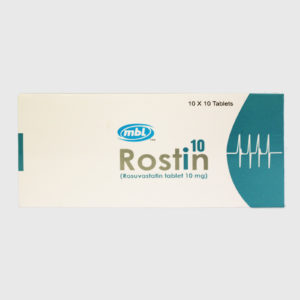
Each film coated tablet contains:
Rosuvastatin calcium equivalent to Rosuvastatin 10mg
Hyperlipidemia and Mixed Dyslipidemia
Rosuvastatin is indicated as adjunctive therapy to diet to reduce elevated Total-C, LDL-C, ApoB, non HDL-C, and triglycerides and to increase HDL-C in adult patients with primary hyperlipidemia or mixed dyslipidemia. Lipid altering agents should be used in addition to a diet restricted in saturated fat and cholesterol when response to diet and non-pharmacological interventions alone has been inadequate.
10mg once daily, increased if necessary after ot less than 4 weeks to 20mg once daily,Increased after further 4 weeks to 40mg only in severs hypercholesterolaemia with high cardiovascular risk and under specialist supervision, patient of angina Max.20mg per day
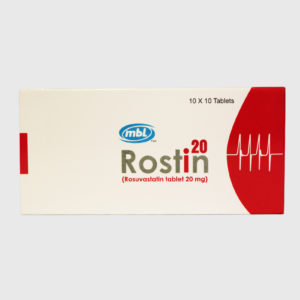
Each film coated tablet contains:
Rosuvastatin calcium equivalent to Rosuvastatin 20mg
Hyperlipidemia and Mixed Dyslipidemia
Rosuvastatin is indicated as adjunctive therapy to diet to reduce elevated Total-C, LDL-C, ApoB, non HDL-C, and triglycerides and to increase HDL-C in adult patients with primary hyperlipidemia or mixed dyslipidemia. Lipid altering agents should be used in addition to a diet restricted in saturated fat and cholesterol when response to diet and non-pharmacological interventions alone has been inadequate.
10mg once daily, increased if necessary after ot less than 4 weeks to 20mg once daily,Increased after further 4 weeks to 40mg only in severs hypercholesterolaemia with high cardiovascular risk and under specialist supervision, patient of angina Max.20mg per day
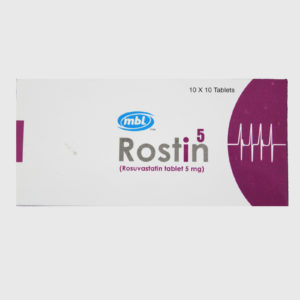
Each film coated tablet contains:
Rosuvastatin calcium equivalent to Rosuvastatin 5mg
Hyperlipidemia and Mixed Dyslipidemia
Rosuvastatin is indicated as adjunctive therapy to diet to reduce elevated Total-C, LDL-C, ApoB, non HDL-C, and triglycerides and to increase HDL-C in adult patients with primary hyperlipidemia or mixed dyslipidemia. Lipid altering agents should be used in addition to a diet restricted in saturated fat and cholesterol when response to diet and non-pharmacological interventions alone has been inadequate.
10mg once daily, increased if necessary after ot less than 4 weeks to 20mg once daily,Increased after further 4 weeks to 40mg only in severs hypercholesterolaemia with high cardiovascular risk and under specialist supervision, patient of angina Max.20mg per day
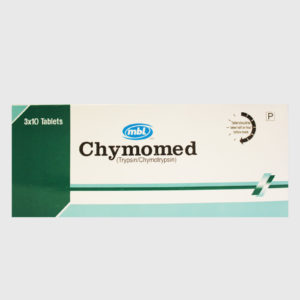
Each tablet contains:
Trypsin and chymotrypsin 50,000 units in 6:1 ratio TabletIndication:
Chymomed Tablets are primarily used for the treatment of acute inflammatory edema associated with Accidental and surgical trauma, Episiotomies, Intervertebral disc herniation, Sciatica, Thrombophlebitis, Vasectomies, Reduction in viscosity in mucus and sputum associated with bronchitis, rhinitis and sinusitis and reduction in various gastro-intestinal disorder.
For adult patients, the recommended (initial) dose of Chymomed Tablets 1 tablets 4 times a day, while the maintenance dosage is 1 tablet twice a day.